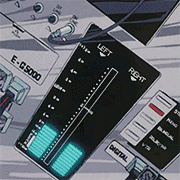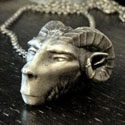|
If the top piece is also flat you could attach the walls to it, print it face down, and then print the remaining piece nurples up
|
|
|
|

|
| # ? Jun 8, 2024 17:24 |
|
What purpose do those extrusions serve? Why not maintain the holes and put 45-degree chamfers from the base to the tip, reorient the part vertically and print without supports (& find out how well your slicer settings for bridging work on the narrower bridge profile)?
|
|
|
|
Most of the plastics we use with FDM are quite easy to glue, and that kind of part is well served by making a bore (that will bridge) register a separately printed part that gets glued in. I'm a big fan of SCIGRIP 16 with PLA, ABS and PC (and it should work on plenty of others). Works with PETG as well, though not as well.
|
|
|
|
Dominoes posted:Thank you. I'm considering sanding now, and seeing if that helps. Regrettably, I don't think cooling fan or lower temperature are feasible; the only way I've been able to get this not to split is maxed out temp, with fan off. I'm trying a run now with the face flat. (ie removed the fillets on the bottom edges). Another consideration for improving aesthetics is that since you're printing these in ABS you could consider smoothing them with Acetone. You won't get a perfect finish since it just dissolves the outside slightly, but it might be preferable to the current look. You can also use acetone to stick ABS parts together since they get a little mushy. You can brush it on for a little targeted melting or for a more consistent smoothness there's vapor smoothing, where you wet some paper towels or rags with acetone and place the part in a sealed container with a platform for the model that's away from direct contact with the acetone. There's a ton of information about it but as folks have transitioned away from printing ABS in recent years it's not talked about as often. Polymaker also makes filaments that are easier to print than ABS and can be smoothed with isopropyl alcohol as well. They produce some smoothing containers that vaporize isopropyl to smooth the model consistently, too. As an aside, I think goons have often recommended eSun ABS+ specifically as having less warping and being a little easier to print than regular ABS. Here's a 2014 video from Angus at Maker's Muse about acetone smoothing: https://www.youtube.com/watch?v=5sblh0bBHoQ Here's a 2016 video from DIY Perks: https://www.youtube.com/watch?v=6xFUNFG-UKE
|
|
|
|
On that note, does anyone have a workflow for finishing resin parts that arenít suited to being tumbled? iím pretty close to making some tooling masters and want to put a very fine finish on the tool face, polished or as close as I can get to it. Itís funny, I can do this no problem if itís made out of metal, but soft plastics call for a whole Ďnother suite of polishing tools/compounds
|
|
|
|
Wet sanding with some high grit is about all I can imagine. Just got a notification that my anycubic wash n cure plus is gonna ship/has shipped! Hooray!  I bought it off the ebay sale so keep an eye out for the shipping mail if you did as well.
|
|
|
|
Ambrose Burnside posted:On that note, does anyone have a workflow for finishing resin parts that aren’t suited to being tumbled? i’m pretty close to making some tooling masters and want to put a very fine finish on the tool face, polished or as close as I can get to it. It’s funny, I can do this no problem if it’s made out of metal, but soft plastics call for a whole ‘nother suite of polishing tools/compounds Your polishing resin! Holy moly. Is anyone doing vapor smoothing with resin? I'm doing minis so not really the same tier but I haven't had to do much finishing at all outside of just some support cleanup
|
|
|
|
The acrylate resin blend (predominantly) used in SLA printers doesn't dissolve in acetone like ABS does. You might be able to get it to work with something like MEK or dichloromethane, but uhhhh I think I'll pass on having those particular vapors floating around.
|
|
|
|
w00tmonger posted:Your polishing resin! Holy moly. Resin's got a drat good surface finish for something fresh from the printer, but it's honestly still very coarse by metal finishing standards. A scratch in a finished brass/aluminium etc part that you can feel with a fingernail is considered pretty bad and needs some personalized multi-abrasive-grit finishing attention- you can feel every single step in a resin print in the same way if you try; fine for lots of parts, just not a tooling master; there i wanna blend the fine waterline/layer steps into one another without leaving tool/buff marks in the finish. Sandpaper isn't really practical for finishing stuff like 3d dies with really intricately-detailed designs, or at least it's a poor fit for the task compared to something that conforms to the part. Vibratory polishing absolutely works but you don't have much control over the process in terms of targeting the polishing action, that's fine for bulk-finishing miniatures or whatever but it'll over-abrade the high points of a single large tool/mold while overlooking the low points. My first thought is to use a purpose-made plastic polishing compound worked into a felt/stiff cotton Dremel polishing wheel; a nice double-duty cut&colour compound can give you an actual mirror polish with a single buffing pass for a soft material like bone or wood, resin ought to work similarly. Bead blasting or some other gentle/non-cutting blasting medium would be my other pick, wicked fast and offers you the cleanest/most homogenous-looking finish by far- although I have no cabinet access right now so it's moot. If/when I start copper plating prints, though, shot-peening is apparently the way to go- offers a nice burnished surface finish, but also increases part strength significantly by adding uniform work-hardening across the entire part surface. I haven't really thought about solvent polishing because I assumed it was impossible or at least impractical to do to resins at home, same vibratory concerns about the lack of control/targeting also hold i'd think .
|
|
|
|
doublepost: can anybody recommend a UV resin that offers high surface detail and which can withstand high temperatures? also hopefully not $200 a litre? I've got five pounds of lead-bismuth-tin-antimony Low-Melt Specialty Eutectic Alloys coming in the mail, and I'd like to be able to produce casting molds derived from printed resin master models as directly as possible- ideally I can directly cast the molten alloy into a printed mold without needing an intermediary mold cast from sth like gypsum plaster or RTV silicone. Ceramic-type resins seem to fit the bill the best but they're all $$$$ that i've seen. e: gently caress, i didn't realize siraya's sculpt is claimed as heat-resistant up to 160C, and sculpt ultra up to ~220C. naturally that's the one product they don't ship to canada. heck. i think that's basically the only conventional acrylate UV resin I've seen that can survive rubber mold vulcanizing temps and doesn't cost Ceramic Resin Prices silver lining is that they're shipping Build to canada now, that's been on my list for a while as a budget engineering-geared resin Ambrose Burnside fucked around with this message at 03:36 on Apr 27, 2021 |
|
|
|
I feel like you need to somehow monetize videos of your experiments because in like every thread I'm sad I can't help you except by saying "throw money at this it sounds promising"
|
|
|
|
Ambrose Burnside posted:doublepost: can anybody recommend a UV resin that offers high surface detail and which can withstand high temperatures? also hopefully not $200 a litre? I've got five pounds of lead-bismuth-tin-antimony Low-Melt Specialty Eutectic Alloys coming in the mail, and I'd like to be able to produce casting molds derived from printed resin master models as directly as possible- ideally I can directly cast the molten alloy into a printed mold without needing an intermediary mold cast from sth like gypsum plaster or RTV silicone. Ceramic-type resins seem to fit the bill the best but they're all $$$$ that i've seen. Sculpt ultra looks bananas. I've been on the sirayatech Facebook group and it seems like a lot of people are using it (looking at using?) For injection molding
|
|
|
|
Regarding finishing SLA prints I know it won't give an accurate machined face finish but videos keep popping up on YouTube about making "clear" resin prints glass-like by dipping them in clear acrylic. Does it need to look smooth or be smooth?
|
|
|
|
Putting the spool on a bearing assembly in conjunction with the dialing in made for beautiful layers, now I don't have to worry about screwhole blobs with this PETG Finally gonna mount that OctoPi onto the frame and not gently caress with microSD cards anymore
|
|
|
|
Rexxed posted:Another consideration for improving aesthetics is that since you're printing these in ABS you could consider smoothing them with Acetone. You won't get a perfect finish since it just dissolves the outside slightly, but it might be preferable to the current look. You can also use acetone to stick ABS parts together since they get a little mushy. Thank you. I have a bottle nearby - I'd heard about this, but will give it a shot. For this, or other purposes. Hypnolobster posted:Most of the plastics we use with FDM are quite easy to glue, and that kind of part is well served by making a bore (that will bridge) register a separately printed part that gets glued in. I'd thought about that! Would save print time too. If I want the extrusions anyway, could print them separately and weld on. Planning to weld a prefabbed battery case into the inside this way. SchnorkIes posted:If the top piece is also flat you could attach the walls to it, print it face down, and then print the remaining piece nurples up biracial bear for uncut posted:What purpose do those extrusions serve? Why not maintain the holes and put 45-degree chamfers from the base to the tip, reorient the part vertically and print without supports (& find out how well your slicer settings for bridging work on the narrower bridge profile)?
|
|
|
|
Ok, plan is this: Split it into 2 parts, using SW's split plane. Snap fit or weld together. This should fix the look, and probably save net print time, by avoiding infil. Also: Bought a flex steel build plate for Ender 3. Game changer. The default plate was a pain, and ended up tearing in several places after a few weeks of scraping off stuck abs and PETG.
|
|
|
|
GonadTheBallbarian posted:Putting the spool on a bearing assembly i................... The bearing on the spoolholder has nothing to do with it. This is what I meant by: Nerobro posted:And dangerously close to "this is the voodoo I decided was right, now that's what I'm going to tell people". Dominoes posted:Also: Bought a flex steel build plate for Ender 3. Game changer. The default plate was a pain, and ended up tearing in several places after a few weeks of scraping off stuck abs and PETG.
|
|
|
|
Nerobro posted:The bearing on the spoolholder has nothing to do with it. This is what I meant by: It worked, that's good enough for me.
|
|
|
|
space uncle posted:Try using this print to figure out z level: Amazing, thank you so much! I seemed to have it dialed in and the whistle print came out relatively flawless. I have some more questions but need to take pictures so I can give some context. Ambrose Burnside posted:Resin's got a drat good surface finish for something fresh from the printer, but it's honestly still very coarse by metal finishing standards. A scratch in a finished brass/aluminium etc part that you can feel with a fingernail is considered pretty bad and needs some personalized multi-abrasive-grit finishing attention- you can feel every single step in a resin print in the same way if you try; fine for lots of parts, just not a tooling master; there i wanna blend the fine waterline/layer steps into one another without leaving tool/buff marks in the finish. Sandpaper isn't really practical for finishing stuff like 3d dies with really intricately-detailed designs, or at least it's a poor fit for the task compared to something that conforms to the part. Vibratory polishing absolutely works but you don't have much control over the process in terms of targeting the polishing action, that's fine for bulk-finishing miniatures or whatever but it'll over-abrade the high points of a single large tool/mold while overlooking the low points. I work in jewellery with 3d printed resin as our primary material we use to cast. If I was going to polish resin I'd hit it with some 3M radial wheels and then finish on a cotton buff with some plastic polishing compound. A felt buff might also work and give you a flatter finish but you'd have to do some tests. Vibratory might work, but the mechanical action could also severely round edges. I've done some tests with magnetic tumblers but they are definitely too aggressive. Ultimately, for us, it's much easier, more forgiving, and more manageable to finish the parts in metal so I've never really thought about polishing resin past 400 emery.
|
|
|
|
Nerobro posted:The bearing on the spoolholder has nothing to do with it. This is what I meant by: I disagree. I used to have my filament rolls on a rod and you could see where it pulled on the print. Getting bearings on the spool mount definitely helped.
|
|
|
|
ImplicitAssembler posted:I disagree. I used to have my filament rolls on a rod and you could see where it pulled on the print. Getting bearings on the spool mount definitely helped. I've definitely had prints impacted by a spool resisting too hard, but it was always my own stupidity/impatience leading me to set up some bonkers filament path. These days I use the "Filler" style spool holders from thingiverse, but not because of the bearings- they've got a whole bunch of interchangeable mounting brackets ready to print
|
|
|
|
ImplicitAssembler posted:I disagree. I used to have my filament rolls on a rod and you could see where it pulled on the print. Getting bearings on the spool mount definitely helped. You're taking the wrong lesson from that here. You want consistent tension, not necessarily "none". With both of my filament feed setups, there's no "load/unload" cycle, and the spool just slowly turns. The pursuit/obsession with less friction, is... not the right angle. A few places to look: The prusa printed parts, are printed from filament holders without bearings. Voron doesn't suggest any bearings for their print holders. None of the commercial FDM printers i'm aware of has had anything more than a "spool in a box" setup.
|
|
|
|
Nerobro posted:You're taking the wrong lesson from that here. You want consistent tension, not necessarily "none". Yes. Having a bearing based setup ensured that I had constant tension.
|
|
|
|
I finally got off my lazy bones and re-leveled the FFCP using the new wingnut dials that I printed a few weeks ago before the AC crapped out and printed on the new spring steel bed after re-leveling. This thing is magical for PLA! I printed a simple accessory cup and lid and aside from a few minor blobs and seeing the vertical layer line where the thing starts each layer, it turned out quite well. I'm gonna end up printing out a few vases to replace the cheapo store bought ugly vases we have for the house plants (not all of them are ugly but some are) and see how it goes. I'm almost out of my first 1kg spool of PLA but I have plenty more to start working with soon. If natural PLA ends up working out well from Protopasta I'm just gonna save myself the hassle and just print everything au naturale in the future and airbrush / spraypaint if I need a part to look some kind of different color.
|
|
|
|
Doesn't a feed tube to make sure you have a consistent feed path length do more for tension than anything with bearings?
|
|
|
|
Claes Oldenburger posted:I work in jewellery with 3d printed resin as our primary material we use to cast. If I was going to polish resin I'd hit it with some 3M radial wheels and then finish on a cotton buff with some plastic polishing compound. A felt buff might also work and give you a flatter finish but you'd have to do some tests. Yeah, if I were dojng wax burnout or something iíd just polish the final casting, unfortunately iíd be making composite tools with thin copper shells that will pick up very fine model detail well and are too thin to permit anything with any Ďcutí. shot-peening might let me get away with no prep before plating, if I donít end up needing completely different prep like abrasive media blasting to improve the Ďtoothí of the part to be plated. which i hope isnít a problem b/c ugh if i end up working with unplated eutectic alloy tools i can directly polish the tool face, but i really donít want to polish a high-lead alloy, i donít need that poo poo floating around in my shop space. Maybe i can get away with burnishing or something if i have to. Ambrose Burnside fucked around with this message at 19:33 on Apr 27, 2021 |
|
|
|
Are you electroplating or electroforming the copper shells directly onto the resin? Honestly I think some wet sanding up to 600/1200 and then hitting it with a cotton buff would work great and is likely your best bet. Electroplating/forming doesn't normally require a tooth as long as the material to be plated can be plated. Electroplating/forming is the last step (in jewellery production) so making the piece perfect and polished has to happen first. Polishing lead alloys is definitely not a great idea!
|
|
|
|
Nerobro posted:You're taking the wrong lesson from that here. You want consistent tension, not necessarily "none". This is what was happening- I didn't include it in the posts until I had time to watch the filament but it was getting pulled, and the spool was dropping too much and it bound/crimped when it looped on the corner of the extruded aluminum bars etc. Moving it to the dryer/storage thing with the bearing assembly to the side of the printer allowed for consistent tension, which wasn't possible with Creality's static rod on the top of the printer
|
|
|
|
I figure this would be of interest to new 3d printer folks (of which I still am): https://www.youtube.com/watch?v=t_7EMnQ6Rlc
|
|
|
|
Claes Oldenburger posted:Are you electroplating or electroforming the copper shells directly onto the resin? Honestly I think some wet sanding up to 600/1200 and then hitting it with a cotton buff would work great and is likely your best bet. I'm planning on experimenting with two complementary things and seeing the results I can realistically achieve: 1) directly electroforming onto carbon-painted resin parts, for the purpose of making strong, low-friction and UV-stable mechanical/functional parts (ideally aesthetic/decorative stuff too but iirc acid copper electroplating does not give the prettiest results so we'll see) This is where I've heard a little bit of tooth can help with long-term adhesion, haven't actually tried it myself tho. 2) making 'Rapid Tooling' quick/cheap 3D conforming dies for metal stamping by using a process I'm adapting from industry. here's a post i made about it previously: https://forums.somethingawful.com/showthread.php?noseen=1&threadid=2734977&pagenumber=599&perpage=40&highlight=rapid,tooling#post511950114 the sparknotes workflow is: 3d print a negative master model, cast a positive off the model using low-melting eutectic alloys, plate over the eutectic casting, using it as a consumable forming mandrel; melt the alloy out of the thin electroformed copper shell, then backfill it with a different eutectic alloy that's specifically-formulated for use as a press tool. all the eutectic alloys are infinitely reusable. also 3) i guess, which sidesteps plating altogether- directly casting that press tooling eutectic alloy into 3d printed negative molds, and then using that tooling to directly stamp parts. this would make for shittier, less durable tools with less surface detail, and the lead contacts/contaminates the metal being formed here, which I'm trying to avoid- but it'd be lightning-fast and easy, and also avoids electroforming, which might become important should I fail to achieve the significant electroforming quality control I'll need for this sort of application. and i know how tricky + elusive plating QC can be, esp on a shoestring budget with an experimental process. i'm planning on using a motor and a slip-ring to continuously spin the parts being electroformed in the bath, which is said to dramatically improve the surface quality and consistency of the thrown plating- gets rid of bubbles, eliminates thickness variations from varying proximity between given regions of anode and cathode, etc- one of my plating-specific stretch goals here is to attempt high-precision fit-ups/toleranced mating of printed parts by printing them slightly undersized and then building the plating up til it's bang-on. being able to produce parts with tolerances expressed in microns, plus the low friction of copper, opens the door to very small printed close-fitting mechanical assemblies like micro-pumps/engines, valves etc, with absolutely no machining required. Ambrose Burnside fucked around with this message at 00:20 on Apr 28, 2021 |
|
|
|
aldantefax posted:I figure this would be of interest to new 3d printer folks (of which I still am): He's.. ok... at first watch on this one. Generally, I do not like people publicizing him. He's caused me hours of pain.
|
|
|
|
Well I just never had much luck with feeler gauges, and guess what I just found out? My "0.1 mm" feeler gauge is actually 0.24 mm thick The 0.15 mm feeler was... I don't remember but easily 0.2+ I didn't bother measuring the rest
|
|
|
|
Btw, the steel buildplate (vice standard Ender 3) not only makes the prints easier to remove, it improves the surface. Bottom surface of parts. Left is standard plate, right is steel. Also of note: Unlike the bottom-with-supports being ugly, the bottom directly on steel build plate looks like smooth, almost like an injection-molded part. Probably due to the high build-plate temperature smoothing the finish.
|
|
|
|
The Eyes Have It posted:Well I just never had much luck with feeler gauges, and guess what I just found out? That'd do it. Hope you weren't tuning an engine with those. On a different topic, it's a shame that surface plates are expensive things. Building my Voron 2.4 at the moment, and I did get it nicely square with the aid of an ad-hoc jig made of 2040, but it'd have been so much easier if I had a properly flat surface. Does anyone have a good solution for putting roll in t-nuts into 2020 grooves? It seems I need too much force, so I'm pretty sure I'm doing it wrong, and am really considering if I should work out how to slide these in prior.
|
|
|
|
Are those the ones that self align when you screw into them? I gouged a few good spots on my router before I caught on that they did that.
|
|
|
|
snail posted:Does anyone have a good solution for putting roll in t-nuts into 2020 grooves? It seems I need too much force, so I'm pretty sure I'm doing it wrong, and am really considering if I should work out how to slide these in prior. There's different profiles of 2020 and you might have v-slot rather than the squarish profile
|
|
|
|
The Eyes Have It posted:Well I just never had much luck with feeler gauges, and guess what I just found out? A quarter of a millimetre is pretty close to 0.1 of an inch, I think somebody's just changed the the "inch" to "mm" and thrown it up on Alibaba.
|
|
|
|
Is there another repository of stuff to print other than thingiverse? The UI/functional "charm" of thingiverse is starting to get annoying/harder to find what i want/find new poo poo to print just because.
|
|
|
|
Yeggi.com will search a bunch of sites, both free and paid, for STL files. It's frequently much better at finding stuff on Thingiverse than Thingiverse is.
|
|
|
|

|
| # ? Jun 8, 2024 17:24 |
|
toplitzin posted:Is there another repository of stuff to print other than thingiverse? Yeah there's a few sites, though thingiverse seems to be the biggest by virtue of age despite its poor performance. https://www.prusaprinters.org/ https://cults3d.com/en https://www.youmagine.com/ https://thangs.com/ Probably some more as well but those are what I can think of with two hours of sleep.
|
|
|






































